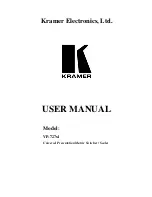
CHAPTER 13: RAPID SPANNING TREE PROTOCOL
CONFIGURING RSTP THROUGH THE COMMAND LINE INTERFACE
MULTILINK ML810 MANAGED EDGE SWITCH – INSTRUCTION MANUAL
13–7
•
State
: Indicates the STP state of individual ports. Values can be Listening, Learning,
Forwarding, Blocking and Disabled.
•
Des. Bridge
: This is the port's designated root bridge
•
Des. Port
: This is the port's designated root port
Another example of the same command, from a larger network with several switches is
shown in Example 13-3. Note the
show stp ports
command can be executed from the
manager level prompt or from RSTP configuration state as shown in the screen captures
earlier
In this example, ports 9 and 10 have a path cost of 20000 and are the least cost paths.
These ports are connected to other switches and the ports are enabled as forwarding
ports. Ports 6 and 7 are also connected to other switches. From the state column, it
indicates that port 7 is in a standby state as that port is discarding all traffic.
More CLI commands associated with RSTP in the RSTP configuration mode are shown
below. The
forceversion
command sets the STP or RSTP compatibility mode.
forceversion
<stp|rstp>
The
show-forceversion
command displays the current forced version.
show-forceversion
The
show-timers
command displays the values of the timers set for RSTP.
show-timers
Table 13–1: Path cost as defined in IEEE 802.1d / 802.1w
Port type
STP path cost
RSTP path cost
10 Mbps
100
2000000
100 Mbps
19
200000
1 Gbps
4
20000
10 Gbps
2
2000
Example 13-3: RSTP information from a network with multiple switches
ML810(rstp)##
show stp ports
RSTP Port Configuration
-------------------------------------------------------------------------------
Port# Type Priority Path Cost State Des. Bridge Des. Port
-------------------------------------------------------------------------------
01 TP(10/100) 128 200000 Forwarding 80:00:00:20:06:30:00:01 00:01
02 TP(10/100) 128 2000000 Disabled 00:02
03 100MB Fiber 128 200000 Disabled 00:03
04 100MB Fiber 128 200000 Disabled 00:04
















































